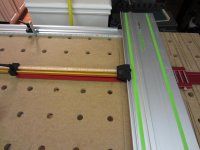Howdy ya'll [big grin]
I have a project coming up to build some large cabinets for my laundry room. I need to cut some large pieces that will be 12" x 70". I've done a search on parallel guides and hear some mixed things about them. Some people think they're great, some people think an aftermarket product is better.
If I could try to explain what I think the process would be, and ya'll can chime in to let me know if I'm heading down the right path.
I have a 42" rail and a 55" rail that I'll be joining together. The sheets I'll be purchasing will be 48" x 96" of melamine.
1) Make a full rip cut to clean up edge.
2) Make a cut roughly 24" so that I will end up with a 48" x 72" sheet.
3) Use the parallel guides to assist in making my two 12" x 72" pieces
4) Put my new 12" x 72" piece on my MFT/3, but the long side up to the fence to roughly cut off one end and flip it over to cut the opposite end to obtain my final 70".
My overall question is, based on the process I listed above, would my piece also be perfectly square if my MFT/3 is setup correctly? The whole idea for me is that I would like to build these large cabinets as accurately as I can.
I'm also trying to decide if I should buy the Festool Parallel Guide Extension Set or go with something else like the one offered by Seneca Woodworking? I found this thread Parallel Guides vs Rip Guides vs Parallel Guide System where people seem to be pretty unhappy with the Festool product...
I have a project coming up to build some large cabinets for my laundry room. I need to cut some large pieces that will be 12" x 70". I've done a search on parallel guides and hear some mixed things about them. Some people think they're great, some people think an aftermarket product is better.
If I could try to explain what I think the process would be, and ya'll can chime in to let me know if I'm heading down the right path.
I have a 42" rail and a 55" rail that I'll be joining together. The sheets I'll be purchasing will be 48" x 96" of melamine.
1) Make a full rip cut to clean up edge.
2) Make a cut roughly 24" so that I will end up with a 48" x 72" sheet.
3) Use the parallel guides to assist in making my two 12" x 72" pieces
4) Put my new 12" x 72" piece on my MFT/3, but the long side up to the fence to roughly cut off one end and flip it over to cut the opposite end to obtain my final 70".
My overall question is, based on the process I listed above, would my piece also be perfectly square if my MFT/3 is setup correctly? The whole idea for me is that I would like to build these large cabinets as accurately as I can.
I'm also trying to decide if I should buy the Festool Parallel Guide Extension Set or go with something else like the one offered by Seneca Woodworking? I found this thread Parallel Guides vs Rip Guides vs Parallel Guide System where people seem to be pretty unhappy with the Festool product...








